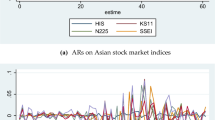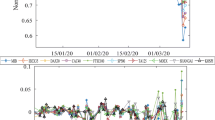Abstract
This chapter investigates how the financial markets react to the coronavirus outbreak by utilizing an event-study approach. We consider several news-based positive and negative COVID-19 events and their impact on emerging vs. developed markets and major asset classes. We examine the impact of COVID-19 events on the implied volatility of the global financial system, which is strongly observed in March 2020. Even during black swan events, we observe the asymmetric impact of coronavirus outbreaks across assets and markets. The response of black swan events generates a pronounced investor reaction. We also observe the role of ‘Animal Spirits’ through ‘Narrow Framing’ as investors seem to consider the pandemic as short-term shocks.
Access this chapter
Tax calculation will be finalised at checkout
Purchases are for personal use only
Similar content being viewed by others
Notes
- 1.
The number of regimes is decided based on the appropriate lag structure, statistical criteria, and the diagnostic results of results. We have considered two regime MS-DR models for our analysis.
- 2.
To conserve space, we have reported the January and February results in Appendix (Table 3).
References
Ahmad, W., Kutan, A. M., & Gupta, S. (2021a, in press). Black swan events and COVID-19 outbreak: Sector level evidence from the US, UK, and European stock markets. International Review of Economics & Finance.
Ahmad, W., Hernandez, J. A., Saini, S., & Mishra, R. K. (2021b). The US equity sectors, implied volatilities, and COVID-19: What does the spillover analysis reveal? Resources Policy, 72, 102102.
Ahmad, W., Chahal, K. J. R., & Rais, S. (2021c, in press). A firm-level analysis of the impact of the coronavirus outbreak in ASEAN. ERIA Discussion Paper Series.
Akerlof, G. A., & Shiller, R. J. (2010). Animal spirits: How human psychology drives the economy, and why it matters for global capitalism. Princeton University Press.
Al-Awadhi, A. M., Al-Saifi, K., Al-Awadhi, A., & Alhamadi, S. (2020). Death and contagious infectious diseases: Impact of the COVID-19 virus on stock market returns. Journal of Behavioral and Experimental Finance, 27, 100326.
Ali, M., Alam, N., & Rizvi, S. A. (2020). Coronavirus (COVID-19)—An epidemic or pandemic for financial markets. Journal of Behavioral and Experimental Finance, 100341.
Bai, J., & Perron, P. (2003). Computation and analysis of multiple structural change models. Journal of Applied Econometrics, 18(1), 1–22.
Barberis, N. C., **, L. J., & Wang, B. (2020). Prospect theory and stock market anomalies (No. w27155, pp. 1–61). National Bureau of Economic Research (NBER).
Bevilacqua, M., Morelli, D., & Uzan, P. S. (2019, in press). Asymmetric implied market volatility and terrorist attacks. International Review of Financial Analysis, 67.
Doornik, J. A. (2013). A Markov-switching model with component structure for US GNP. Economics Letters, 118(2), 265–268.
Hamilton, J. D. (1989). A new approach to the economic analysis of nonstationary time series and the business cycle. Econometrica, 57(2), 357–384.
Harjoto, M. A., Rossi, F., Lee, R., & Sergi, B. S. (2021). How do equity markets react to COVID-19? Evidence from emerging and developed countries. Journal of Economics and Business, 115, 105966.
Haroon, O., & Rizvi, S. A. (2020). COVID-19: Media coverage and financial markets behavior—A sectoral inquiry. Journal of Behavioral and Experimental Finance, 27, 100343.
Sharif, A., Aloui, C., & Yarovaya, L. (2020). COVID-19 pandemic, oil prices, stock market, geopolitical risk and policy uncertainty nexus in the US economy: Fresh evidence from the wavelet-based approach. International Review of Financial Analysis, 101496.
Topcu, M., & Gulal, O. S. (2020). The impact of COVID-19 on emerging stock markets. Finance Research Letters, 36, 101691.
WEF. (2020, March 23). Mad March: How the stock market is being hit by COVID-19. Retrieved May 23, 2020, from https://www.weforum.org/: https://www.weforum.org/agenda/2020/03/stock-market-volatility-coronavirus/
Zhang, D., Hu, M., & Ji, Q. (2020). Financial markets under the global pandemic of COVID-19. Finance Research Letters, 101528.
Acknowledgements
The study was presented at the ‘Virtual Conference on International Macroeconomics and Finance’ in the honor of ‘Prof. Bandi Kamaiah.’ We are thankful to ‘Naoyuki Yoshino’ for insightful suggestions. We are also thankful to Gazi Salah Uddin and Stelios Bekiros for their comments and suggestions on the first draft of this paper. The authors would like to acknowledge the DST-SERB (grant # MTR/2019/001035) for their generous financial support.
Author information
Authors and Affiliations
Corresponding author
Editor information
Editors and Affiliations
Appendix
Appendix
Rights and permissions
Copyright information
© 2022 The Author(s), under exclusive license to Springer Nature Singapore Pte Ltd.
About this chapter
Cite this chapter
Ahmad, W., Gupta, S., Rais, S. (2022). Understanding the Impact of COVID-19 on Financial Markets: Animal Spirits or Black Swan?. In: Yoshino, N., Paramanik, R.N., Kumar, A.S. (eds) Studies in International Economics and Finance. India Studies in Business and Economics. Springer, Singapore. https://doi.org/10.1007/978-981-16-7062-6_31
Download citation
DOI: https://doi.org/10.1007/978-981-16-7062-6_31
Published:
Publisher Name: Springer, Singapore
Print ISBN: 978-981-16-7061-9
Online ISBN: 978-981-16-7062-6
eBook Packages: Economics and FinanceEconomics and Finance (R0)




